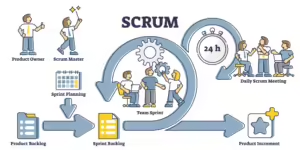Agile software development methods: Flexibility and efficiency in software creation
Agile software development methods have revolutionized the software development landscape. They enable a flexible, iterative and customer-focused approach that differs greatly from traditional, plan-based approaches. Agile methodologies emphasize the importance of teamwork, customer feedback, and the ability to quickly adapt to change. This article provides an overview of Agile methods, their principles and common practices.
Basics of Agile Software Development
Agile software development is based on the “Agile Manifesto”, which was formulated in 2001 by a group of software developers. The core principles are:
- Individuals and interactions via processes and tools.
- Working software with comprehensive documentation.
- Customer cooperation through contract negotiation.
- Responding to change by following a plan.
Popular Agile Methods
- Scrum: Scrum is an agile development framework that focuses on team organization and project management. It uses short iterations, called sprints, and daily meetings (Daily Scrums) to monitor progress and coordinate tasks.
- Kanban: Kanban is a visual method for managing software development with a focus on continuous delivery and minimizing work in progress (WIP). It uses a Kanban board to visualize progress.
- Extreme Programming (XP): XP is a method that aims to improve software quality and responsiveness to customer requirements. It emphasizes technical practices such as continuous integration, test-driven development (TDD), and pair programming.
- Lean Software Development: Inspired by the Lean principles of efficient production, Lean Software Development focuses on minimizing waste and maximizing value for the end customer.
- Feature-Driven Development (FDD): This method focuses on developing and deploying features, broken down into smaller, manageable activities.
Advantages of Agile Software Development
- Flexibility: Agile methods enable quick adjustments to changes and new requirements.
- Customer focus: Regular feedback from customers ensures that the final product meets their needs.
- Efficiency: Through iterative development and continuous testing, errors can be identified and corrected at an early stage.
- Team dynamics: Agile methods promote collaboration and self-organization of teams.
Challenges in agile software development
- Cultural change: The transition to agile methods often requires a significant change in the company culture.
- Scaling: Effectively scaling agile methods in large, complex projects can be challenging.
- Misinterpretations: Misunderstandings about agile principles can lead to ineffective practices.
Future of Agile Software Development
Agile methods are constantly evolving and are increasingly being integrated with other techniques and technologies, such as DevOps and artificial intelligence. They are expected to continue to play a central role in software development, especially in a rapidly changing technological landscape.
Conclusion
Agile software development methods offer a flexible, efficient and customer-focused approach to software creation. They enable teams to respond quickly to changes and deliver products that meet users' needs. Despite some challenges, they have become a standard in software development and are expected to remain so in the future.






